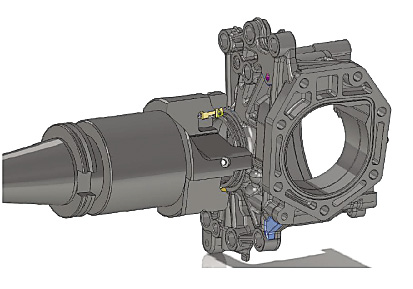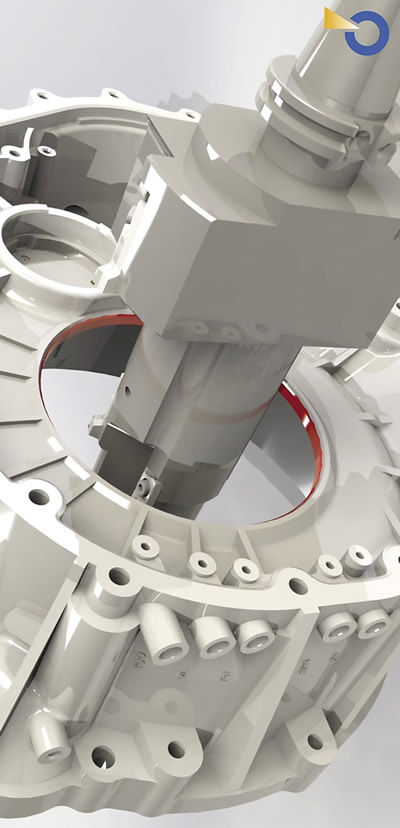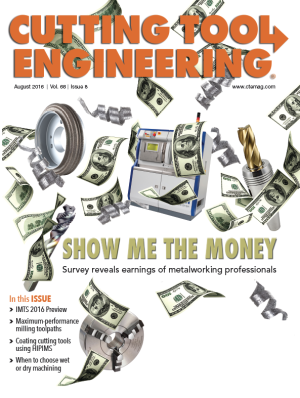END USER: General Products Corp., (260) 668-1475, www.general-products.com. SOLUTION PROVIDERS: Haggard & Stocking Associates Inc., (800) 622-4824, www.haggard-stocking.com; Rigibore Inc., (262) 363-3922, www.rigiboreinc.com. CHALLENGE: Overcome the concerns of applying fixed-pocket, brazed-PCD boring tools. SOLUTION: Special “one-shot” adjustable boring tools that accept replaceable PCD inserts.

Fixed-pocket, brazed-PCD boring tools can run for long stretches of time while producing mass quantities of high-quality parts, but only when everything in the setup is correct. That includes the setting of the PCD cutting edges, TIR, clearance, back taper and hone.
However, if some aspect of the costly cutters isn’t right, problems result, with the potential to halt production, according to Dennis Amstutz, manufacturing engineer at General Products Corp. The Livonia, Mich., job shop provides machined assemblies found in almost all modes of transportation, including automotive vehicles and medium- and heavy-duty trucks.


Rigibore designs and develops CAT 50 special boring tools and special turning tools, including ones for General Products. Images courtesy Rigibore.


Amstutz said a new brazed-PCD boring tool costs from $2,000 to $7,000 and, on average, it costs about $2,000 to have one reconditioned when it dulls and begins to generate inconsistent bore sizes and finishes. In addition to the expense, the lead time for a retipped tool is typically 8 weeks or more.
Regardless of the lead time, reconditioning a PCD-brazed boring tool that’s been run 2 years or more and machined in excess of 65,000 parts doesn’t mean it will perform as well the second time around. Size, taper and TIR can change during the retipping process, and General Products couldn’t “plug and play” a reconditioned tool with confidence. “It’s a 50/50 shot whether it’s going to be correct or not,” Amstutz said, adding that the company sometimes needs to modify part programs to produce acceptable parts.
There’s no guarantee that a new fixed-pocket boring tool is going to cut correctly either, Amstutz noted. He added that having everything right on a boring tool is especially critical for General Products because a lot of the bores on its parts have tolerances of ±12µm (0.0005”). “It’s just kind of a crapshoot.”
To find a more-consistent solution, Amstutz turned to Kevin Burnett, executive vice president of Haggard & Stocking Associates Inc.’s Fort Wayne, Ind., distributorship. Burnett recommended Smartbore adjustable boring tools that accept PCD inserts from Rigibore Inc., Mukwonago, Wis.
According to Rigibore, its hand-held, digital Smartbore Adjuster enables both skilled and semiskilled operators to quickly and easily make manual, micron-accurate adjustments to the cutting edges of a fine boring tool while it is in the machine spindle. The rigid design reportedly eliminates backlash and ensures a consistent, accurate performance without risking movement when clamping and unclamping. In addition, Smartbore cartridges fit ISO pockets.
“Let’s say an operator misloads a tool or there’s a crash,” Amstutz said. “More often than not, you are just going to destroy an insert and/or cartridge—and inserts and cartridges are replaceable. No major repair is needed, as it would be for brazed-in tooling.”
While the PCD inserts for the Smartbore tools provide the same durability as brazed-PCD tools, in the case of insert damage or wear, Smartbore tools may take a couple of hours to reset in a worst-case scenario, according to Amstutz. This eliminates the problems associated with regrinding PCD-brazed tools.
At General Products, a Smartbore boring tool replaced a brazed-PCD tool with four cutting edges, which ran at 1,100 rpm, a 680-sfm (207.3 m/min.) cutting speed and a feed rate of 19.68 ipm (500 mm/min.). In comparison, the adjustable, replacement tool runs at 6,000 rpm, a cutting speed of 3,713 sfm (1,131.7 m/min.) and a feed of 23.62 ipm (600 mm/min.).
Based on the gains realized with Smartbore and after an evaluation of other options, Amstutz enlisted Rigibore’s support to machine an A-383 aluminum, die-cast axle housing for a leading 4×4 automaker. For the job, Rigibore designed, with the assistance of its specialized RADS (Rigibore Automated Design System) software, and produced three special boring tools that rough and finish simultaneously.
“It’s got the roughing insert and the finishing insert in the same tool. They’re just offset from one another,” Amstutz said. “Instead of using two tools, I can do it with one.” This enabled General Products to reduce its tool requirements by 40 percent.
According to Rigibore, its previous successful projects outlined combination tools as an effective means of significantly reducing cycle time. By having multiple cutting edges on one boring bar, two critical diameters can be machined in “one shot.”
In addition, Rigibore produced one special turning tool for finishing the OD of a sill bore hub to achieve a tight tolerance. The turning tool was applied after roughing the hub with a different tool using a single-point insert, Amstutz explained. “The overturning tool has to maintain the concentricity of that outer hub diameter to the front bore on the opposite side within 20µm,” he said, adding that applying two tools instead of one was the only way to maintain that concentricity because of the tight tolerance.
“After 12 months of use,” Burnett said, “Rigibore’s tooling-package offering of on-time delivery, ease of setup, onsite reporting, bore size consistency, fine bore finish, short cycle time and total finish-bore costs exceeded expectations.”
Related Glossary Terms
- backlash
backlash
Reaction in dynamic motion systems where potential energy that was created while the object was in motion is released when the object stops. Release of this potential energy or inertia causes the device to quickly snap backward relative to the last direction of motion. Backlash can cause a system’s final resting position to be different from what was intended and from where the control system intended to stop the device.
- boring
boring
Enlarging a hole that already has been drilled or cored. Generally, it is an operation of truing the previously drilled hole with a single-point, lathe-type tool. Boring is essentially internal turning, in that usually a single-point cutting tool forms the internal shape. Some tools are available with two cutting edges to balance cutting forces.
- boring bar
boring bar
Essentially a cantilever beam that holds one or more cutting tools in position during a boring operation. Can be held stationary and moved axially while the workpiece revolves around it, or revolved and moved axially while the workpiece is held stationary, or a combination of these actions. Installed on milling, drilling and boring machines, as well as lathes and machining centers.
- clearance
clearance
Space provided behind a tool’s land or relief to prevent rubbing and subsequent premature deterioration of the tool. See land; relief.
- cutting speed
cutting speed
Tangential velocity on the surface of the tool or workpiece at the cutting interface. The formula for cutting speed (sfm) is tool diameter 5 0.26 5 spindle speed (rpm). The formula for feed per tooth (fpt) is table feed (ipm)/number of flutes/spindle speed (rpm). The formula for spindle speed (rpm) is cutting speed (sfm) 5 3.82/tool diameter. The formula for table feed (ipm) is feed per tooth (ftp) 5 number of tool flutes 5 spindle speed (rpm).
- feed
feed
Rate of change of position of the tool as a whole, relative to the workpiece while cutting.
- inches per minute ( ipm)
inches per minute ( ipm)
Value that refers to how far the workpiece or cutter advances linearly in 1 minute, defined as: ipm = ipt 5 number of effective teeth 5 rpm. Also known as the table feed or machine feed.
- outer diameter ( OD)
outer diameter ( OD)
Dimension that defines the exterior diameter of a cylindrical or round part. See ID, inner diameter.
- polycrystalline diamond ( PCD)
polycrystalline diamond ( PCD)
Cutting tool material consisting of natural or synthetic diamond crystals bonded together under high pressure at elevated temperatures. PCD is available as a tip brazed to a carbide insert carrier. Used for machining nonferrous alloys and nonmetallic materials at high cutting speeds.
- tolerance
tolerance
Minimum and maximum amount a workpiece dimension is allowed to vary from a set standard and still be acceptable.
- total indicator runout ( TIR)
total indicator runout ( TIR)
Combined variations of all dimensions of a workpiece, measured with an indicator, determined by rotating the part 360°.
- turning
turning
Workpiece is held in a chuck, mounted on a face plate or secured between centers and rotated while a cutting tool, normally a single-point tool, is fed into it along its periphery or across its end or face. Takes the form of straight turning (cutting along the periphery of the workpiece); taper turning (creating a taper); step turning (turning different-size diameters on the same work); chamfering (beveling an edge or shoulder); facing (cutting on an end); turning threads (usually external but can be internal); roughing (high-volume metal removal); and finishing (final light cuts). Performed on lathes, turning centers, chucking machines, automatic screw machines and similar machines.

